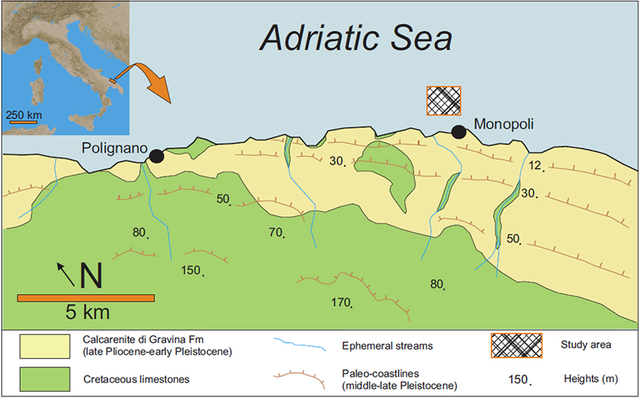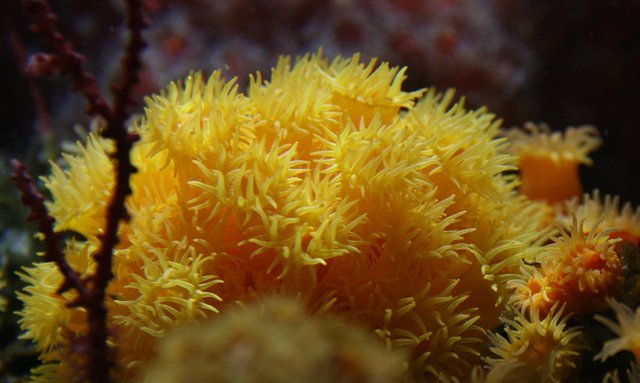A mesophotic coral reef has been discovered for the first time in the Mediterranean Sea
Most of us think of coral reefs as these beautiful, colorful things found on the coast of Australia, in the Maldives, in the Caribbean, and in other exotic places like those. But there are also other types of coral reefs, and today we will be taking a closer look at a mesophotic coral reef that was recently found off the Adriatic coast in Italy.
A mesophotic coral reef is a coral reef that is found in areas with a low light penetration. It is relatively dark here, which allows for far less photosynthesis by algae compared to a regular coral reef found only a few meters below the sea level. The exact depth of the mesophotic coral reefs varies depending on the turbidity of the water, since a higher level of turbidity will reduce how far down the water column the light can penetrate. However, 30 to 40 meters below sea level is a good number, even though these types of reefs can go as far down as 200 meters in places with extremely clear water.

Two photos from the coral reef that was recently found in Italy (more on that below). Photo Giuseppe Corriero et al., published with CC BY 4.0.
Unlike the deep-water coral reefs, most mesophotic reefs do require light to get energy, and have other methods for getting this. The species found in these reefs are also different from both shallow water reefs and deep-water reefs. We know surprisingly little about the mesophotic coral reefs, even though they are found in most oceans around the world. It’s obviously pretty difficult to search the sea floor at 30+ meters down, which is likely the reason why we know so little about them.
The first coral reef in modern day Italy
A research team recently discovered a coral reef just outside the coast of a small city called Monopoli in Italy. This is the first coral reef ever found close to Italy, and is the very first mesophotic coral reef found in the Mediterranean Sea. The reef was found at 30-55m below sea level, and has a framework built from the two corals Phyllangia americana mouchezii and Polycyathus muellerae. It is about 2.5 kilometers long, enough to make it a real coral reef.

A map where the mesophotic coral reef was found. Image by Giuseppe Corriero et al., published with CC BY 4.0.
The species composition of the coral reef was unlike what the researchers said they would have expected from a mesophotic coral reef, which goes to show just how little we know about it. They found surprisingly few calcareous algae species there, which are typically one of the main reef builders, and instead found a reef dominated by invertebrates. Most of the reef-building organisms there lacked algal symbionts, which would be the organism responsible for converting sunlight into energy for the coral, and instead the research team believes that the reef is primarily supported by nutrients that are suspended in the water column. This means that the reef has a lot of similarities with deep-water coral reefs where there is next to no sunlight that reaches the reef.
A total of 153 benthic taxa were represented in the coral reef, where only 9 of them were algae. Most of the biodiversity was in the form of sponges (Porifera sp.), with 59 taxa, over 1/3 of all the species found in the reef. Like other coral reefs, so many different species in a single location is enough to consider it a biodiversity hotspot, even though the diversity is less than what you would find in a surface coral reef in the Pacific Ocean.
Coral reefs in the Mediterranean Sea
Coral reefs are generally very rare in the Mediterranean Sea these days, but they were very common if we go 60+ million years back in time. Anyway, these days we have about 200 species of corals in the Mediterranean. For comparison, there are about 500 species in all of Europe, and 5,600 species worldwide. A unique feature about the corals in the Mediterranean Sea is that it has both species found in Arctic water, as well as species found in tropical waters, so it’s really a good mix of species here. There’s also a few species that are endemic to the Mediterranean Sea, but not very many.
Even with 200 coral species in the Mediterranean Sea, there are very few reefs, and coral species are instead found much more scattered than they would be in reef aggregations. However, big coral structures are still responsible for creating habitats for several species of invertebrates, fish, and microorganisms. This is done by providing shelter and food for the animals.

Astroides calycularisin, one of the coral species found in the Mediterranean Sea. Photo by Manfred Werner, published with CC BY-SA 3.0.
Sadly 13 % of the anthozoan species (this includes most coral-building species) in the Mediterranean Sea are threatened with extinction, including two endemic species. Many of the species are also in the category “Data deficient” because we know very little about them. The biggest perpetrator for the coral species seem to be unsustainable fishing techniques such as bottom trawling and towed dredges, but things like rising sea temperatures, pollution, and invasive species also plays a part in the threat.
It’s worth keeping in mind that a lot of the deeper water areas in the Mediterranean Sea are unexplored, and it seems likely that we might be able to find more mesophotic or deep-water coral reefs if we begin to look more closely for them.
Sources
- Corriero, G., Pierri, C., Mercurio, M., Marzano, C. N., Tarantini, S. O., Gravina, M. F., ... & Giangrande, A. (2019). A Mediterranean mesophotic coral reef built by non-symbiotic scleractinians. Scientific reports, 9(1), 3601.
- The report The corals of the Mediterranean by Oceana. It can be downloaded from https://oceana.org/reports/corals-mediterranean. It’s a great report that does not really require scientific background in the same way that a research paper does, so check it out.
- Otero, M. D. M., Numa, C., Bo, M., Orejas, C., Garrabou, J., Cerrano, C., ... & Linares, C. (2017). Overview of the conservation status of Mediterranean anthozoa. IUCN.
Thanks for stopping by!
I hope you enjoyed reading about the newly discovered mesophotic coral reef in Italy, and the organisms found there. As always, feel free to leave any questions or comments below.
This post was published on the Steemstem.io interface for the Steem blockchain. Make sure to check it out for additional science content.
Amazing news! Coral reefs are such extraordinary and beautiful organisms! It is always heartbreaking for me to see while snorkeling that most of them are already dead here in the Caribbean :(
Beaching of corals and coral reefs is indeed a huge problem, and unfortunately it will only get a lot worse in the coming decades. These organisms are extremely sensitive to both increase in temperature and acidity (lower pH), so it seems highly unlikely that the coral bleaching events will stop anytime soon.
I'm not sure how these mesophotic or the deep-water coral reefs will respond to climate change though, but hopefully it won't be that big of an issue with them since they are less dependent on the symbiotic algae.
I am afraid you are right about the prospects of the tropical corals :( Let´s see how these deep-water corals will do in future.
They probably won't be affected by bleaching at least, since they don't rely on zooxanthellae to do photosynthesis (these are essentially removed from the coral when it gets too hot, leading to a bleaching).
How little we know about the ocean is exactly why I wanted to be a marine biologist...then a minor eardrum injury meant I couldn’t get my dive ticket and it was one of many reasons I spat it and went to arts 🤣
Still fascinated by and love the ocean though, in all its deadly glory 😄
Posted using Partiko iOS
I really wanted to be a marine biologist explorer when I was a child as well, but somehow ended up with a specialization towards freshwater instead :P But at least I get to blog a lot about marine biology here on Steem, so that's something.
Coral reefs are absolutely stunning!
When I did do freediving in summer, it made me realise how underappreciated all marine life is.
Yeah, we don't really appreciate marine life and the oceans in general as much as we should be.
To think that a oceans of mere 30-50m depth are deep enough that humans did not explore them enough.
I think people who are not familiar with oceanic studies (such as myself) seriously underestimate just how much we dont know about the sea.
Well, 50 meters is actually a lot, since you need equipment to get there. And the oceans are huge, so there are many areas that we know next to nothing about. I think we will begin to see more discoveries now that we have better underwater drones though!
Hi @valth!
Your post was upvoted by @steem-ua, new Steem dApp, using UserAuthority for algorithmic post curation!
Your UA account score is currently 5.214 which ranks you at #853 across all Steem accounts.
Your rank has dropped 1 places in the last three days (old rank 852).
In our last Algorithmic Curation Round, consisting of 217 contributions, your post is ranked at #54.
Evaluation of your UA score:
Feel free to join our @steem-ua Discord server
This post has been voted on by the SteemSTEM curation team and voting trail in collaboration with @curie.
If you appreciate the work we are doing then consider voting both projects for witness by selecting stem.witness and curie!
For additional information please join us on the SteemSTEM discord and to get to know the rest of the community!
Wow, too many wonders hidden in the Oceans. By the way, could there be a chance of such mesophotic coral reef having its own exotic fishes?
That's definitely possible, but there didn't seem to be any for this particular reef. But these reefs do create unique habitats that could easily be tied to a particular type or species of fish.
Dear valth:
We are SteemBet, the next generation STEEM based gaming platform. We are honored to invite you to join our first fantastic dice game, which is just the beginning of SteemBet game series. Our dividend system has now launched. The prize pool has already accumulated 2,000 STEEM and more than 60 players have participated in staking mining token SBT. A huge reward of 40,000 STEEM is awaiting! Join us NOW with other 500 STEEM users to loot HUGE dividend reward!!
SteemBet Team
Official Website
https://steem-bet.com
Discord Server
https://discord.gg/95cBN3W
Telegram Group
https://t.me/steembet